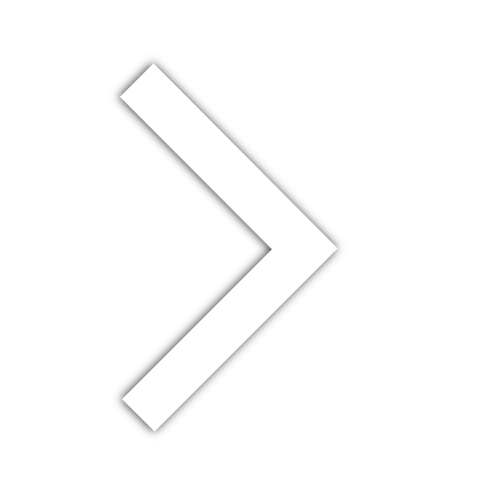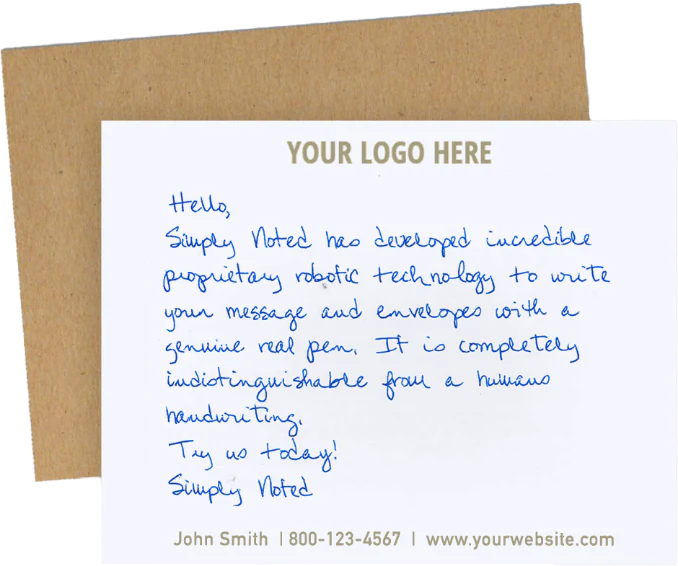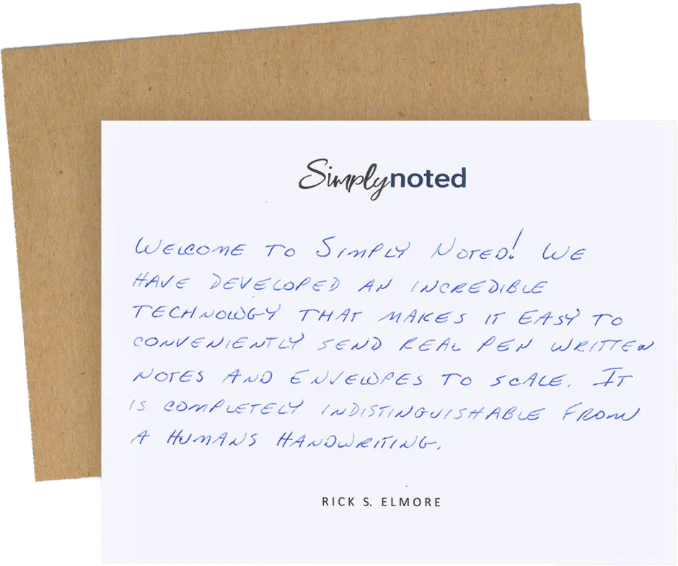Handwritten Fonts - Everything You Need to Know

At Simply Noted, we take handwritten fonts very seriously. Along with our unique, ballpoint pen-wielding handwriting robots, our business is built on our proprietary font technologies. In the process, we’ve created a font system with results that are indistinguishable from text written by a human hand. You simply can’t find more authentic, automated handwritten notes and cards.
Why do we put so much effort into our handwritten fonts? Because our product is only as good as the illusion it creates. Handwriting is immensely personal, and handwritten notes evoke a strong emotional reaction from their recipients.
Anyone can quickly type an email or rattle off a text message, but handwritten notes require an investment of time and energy. They demand planning and focus and are generally reserved for people and events that are special to you. So when you receive a handwritten card, it feels like a special occasion. But only if you believe that it’s genuine. If the handwriting was printed with a laser printer, or if every letter is a uniform size and shape, the illusion is shattered, and any emotional connection your letter might have made is ruined.
That’s why we work to craft the most realistic handwritten fonts available and then use real ballpoint pens to complete the illusion. You can pick from any of our stock fonts or opt to recreate your own. Whichever you choose, the final results are entirely believable. Robots might create your cards, but they get the breath of life from our handwritten fonts. This article will discuss how we pull off such an impressive feat.

WE REPLICATE ALL THE CHARACTERISTICS OF HUMAN HANDWRITING
We’ve all seen first-generation handwriting fonts. You can pick them out from a mile away. The first thing you notice is that every letter looks like every other. As an example, a lower case “e” looks the same no matter where it occurs in the text. Unfortunately, this immediately spoils the illusion because every letter looks slightly different when written by a person.
There are several ways that old-style handwritten fonts fail the authenticity test. We avoid them all by mimicking everything that makes human handwriting unique. We start by using real ballpoint pens.
Realistic Pen Pressure
When you write, you press the tip of your pen into the paper. The more pressure you apply, the deeper the indentation that’s left behind. Not only does this indentation affect the look of the ink, but you can often see it on the other side of the paper, too. It’s subtle enough that you may not notice it’s there, but you’ll know something’s off if it isn’t.
Handwritten fonts that are printed cannot reproduce this effect, whether printed on a photocopier, laser printer, inkjet printer, or even professional printing press. Only a real ballpoint pen will do, and our automated handwriting machines use them. Our system uses variable pressure to perfectly replicate the subtle shifts in line thickness and indentation depth ordinarily present in human handwriting.
SEE ALSO: Why Handwritten Direct Mail Improves Response Rates

Variable Letter Sizing
Humans not only vary the width and depth of their pen strokes, they naturally alter the shape and size of their letters, too. They don’t do this consciously, of course. It’s just a natural consequence of analog human writing. Each time we write a letter or a word, our hand creates the shapes slightly differently. Every lower case “e” has the correct shape, but the loop might be slightly smaller or larger, the tail might extend a bit further, and the size of the letter might change.
As we mentioned earlier, first-generation handwritten fonts can’t replicate this effect. Every letter “e” looks the same as every other one. We use advanced AI to introduce subtle alterations with each letter that’s written. Our fonts recreate the variability found in real handwriting. Two words, written side by side, will look slightly different, just different enough to fool the reader into thinking a real person wrote the text.
Advanced Slant, Spacing, and Stroke
If you haven’t noticed the pattern yet, accurately mimicking human handwriting is all about variability. The challenge is making perfect digital systems operate in messy analog. Another way we do this is by varying the slant of the letters, the spacing between letters and lines, and the width and density of the stroke. We even change the starting point for the first letter on each new line. This vertical “jiggle” is common in human writing but usually missing from printed text.
These variations aren’t random, mind you. Human writing variability isn’t random. It’s based on the way our hand, fingers, and muscles react as we push our pen across the paper. Random alterations would still feel robotic. Our AI analyzes human handwriting, learning where variability happens most often. This creates realistic alterations that we recognize as human, even when they’re not.

Other Unique Writing Characteristics
When your goal is absolute realism, you can’t leave anything to chance. Our AI has learned to recognize a wide range of human handwriting characteristics. More importantly, it can recreate them with each letter it writes.
Ligatures happen when two letters run into each other, forming what looks like a single letter. Hurried human writing often creates ligatures, but most handwritten fonts ignore them by necessity. They simply don’t have a way to recreate them. Our smart fonts can, and will realistically introduce ligatures occasionally when the letter-spacing warrants them.
Not only can we create ligatures, but we also have complete control over the kerning of each letter. Kerning is the space between characters, and this isn’t consistent in human writing. Sometimes it widens, and occasionally, it collapses, creating a ligature. Our AI varies these states for the ultimate handwritten font experience.
YOU HAVE TO SEE IT TO BELIEVE IT
We’re not bragging when we say that our handwritten fonts, and the automated process that converts them into written words, do a remarkable job of recreating real handwritten text. It’s simply a fact. When you order handwritten cards from Simply Noted, you won’t notice the years of research that went into producing the finest handwritten fonts available. You won’t notice because they won’t feel like fonts. Instead, they’ll feel like real human handwriting. If you didn’t know they were written by a robot you would never guess. And neither will your recipients.























